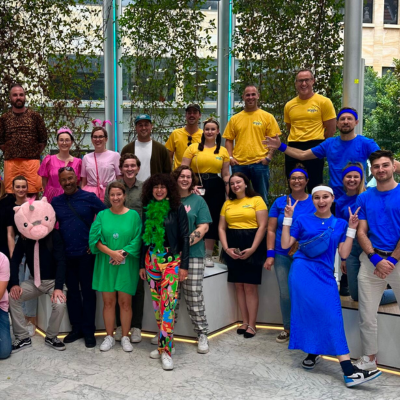At Corporate Challenge Events, we’re excited to share a message that resonates beyond childhood: play is crucial for adults too. We’re preparing to bring this idea to every office, ensuring teams everywhere can embrace the fun and connection play provides. Our mission is clear—reach 1 million people by 2030 and make play a vital part of every workday.
Why focus on play for adults? Because it’s a game-changer in the workplace. Play breaks down barriers, fosters creativity, and builds stronger connections. It transforms the office from a place of routine to a hub of innovation and collaboration. As we look forward to 2025, we’re eager to ignite this movement.
WHY
Play
Let's delve into the fascinating science behind play.
Research consistently shows that play isn’t just a pastime for children; it’s a powerful tool for adults too. The benefits of play extend far beyond fun.
Play is more than an activity; it’s a state of mind.
I want to repeat that concept because it is so powerful. Play is more than any pastime; it is actually a state of mind. Imagine a moment when you were so immersed in an activity that time seemed to slip away unnoticed. Perhaps it was when you were painting, writing, or even playing a sport. Reflect on that experience—what were you doing, and how did it make you feel? This state of being fully engaged is what Mihaly Csikszentmihalyi describes as ‘flow’.
In this state, your attention is fully absorbed in the activity, causing a reduction in self-consciousness and a diminished awareness of time. When in flow, you’re present and completely engaged, much like a child exploring the world with wonder and curiosity. This mindset taps into a natural sense of wonder and joy, allowing you to see things from new perspectives.
As adults, we can tap into this mindset anytime. When we enter the play state, our brains release endorphins. These chemicals boost mood and reduce stress, making us feel happier.
Engaging in play also helps our brains build new neural pathways. This enhances our ability to think creatively and solve problems. It’s like giving your brain a workout, but it’s fun.
Play has a calming effect on the nervous system too. It helps regulate our emotions and response to stress. This means we become better at handling challenges and staying focused in high-pressure situations.
How to integrate cooperative
Play

Creating Play Zones
Designate spaces in the office where employees can unwind and engage in playful activities. Include games, puzzles, or creative materials. To achieve this, assess unused areas in your office that can be transformed into play zones. Ensure these areas are accessible and inviting, fostering an atmosphere of relaxation and creativity.

Team-Building Activities
Plan regular activities that encourage teamwork and fun. These can range from simple in-office games to outdoor team challenges. Team building is not just about trust falls and awkward icebreakers. Modern team-building exercises can be engaging and effective. Consider activities like charity team building, outdoor adventure programs, or collaborative problem-solving tasks. These activities encourage communication, enhance teamwork, and break down barriers.

Scheduling Weekly Playtime
Dedicate a specific time each week for the entire team to engage in playful activities. This could be an hour of group games or creative workshops. Encourage employees to suggest activities they enjoy to increase involvement. Make it a regular feature on the company calendar to highlight its importance.

Incorporating Play into Meetings
Start meetings with a quick game or creative challenge. This sets a positive tone and boosts creativity. To implement this, keep games short and relevant to the meeting’s purpose. Rotate the responsibility of selecting the game among team members to keep it dynamic and inclusive.

Celebrating Achievements with Playful Rewards
Instead of typical rewards, offer fun experiences like team outings or creative workshops. To make this effective, align rewards with employee interests and achievements. This not only motivates but also strengthens team bonds and reinforces a culture of appreciation and enjoyment.

Play Committee
To sustain a playful workplace culture, consider forming a ‘Play Committee’. This team can organise and oversee playful activities, ensuring they align with your company’s goals and values. Encourage employees from various departments to join and share their creative ideas.
Join the Play Movement
Incorporating play into the workplace doesn’t need to be complex to be incredibly effective. In fact, it’s often the simplest and most accessible forms of play that can have the most profound impact. Play is about breaking the monotony, sparking creativity, and fostering positive connections among team members. It can be as straightforward as introducing a weekly riddle (check out our monthly brainteaser here for your chance to win), which not only stimulates the mind but also promotes camaraderie and laughter. The beauty of simplicity in play is that it’s inclusive and can be seamlessly integrated into the daily routine.
So, let’s not underestimate the power of a bit of fun in the midst of our daily tasks. It’s a reminder that amidst our busy schedules and towering to-do lists, the magic of play is never too far away.
After all, as George Bernard Shaw once said, “We don’t stop playing because we grow old; we grow old because we stop playing.”






Recent Comments